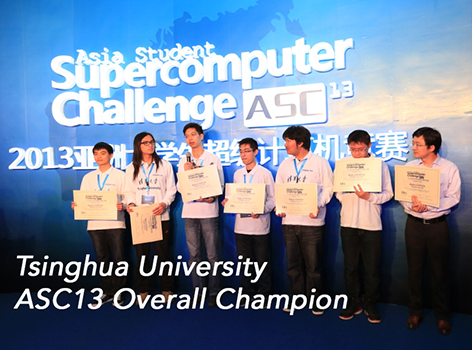The red-hot student cluster team from Tsinghua University in Beijing stepped up their already high-level game and took two of the three awards up for grabs at the inaugural Asia Student Cluster Challenge finals last week in Shanghai.
In doing so, they became the first team in student cluster history to win both the Overall Award (highest average performance on all workloads) and the LINPACK Award for the highest LINPACK score during the same competition.
Winning this latest Overall Award also makes Tsinghua the first ‘three-peat’ student cluster competition champ. They took the top slot at the ISC’12 competition in Hamburg, and they won the All-China play-in competition in the spring of 2012 in Beijing.
In addition to the pride of winning out over nine other university teams, Tsinghua also collects 100,000 RMB ($16,000) for their first-place prize plus an additional 10,000 RMB ($1,600) for setting the top LINPACK score. As one of the two top China finishers, they also get to compete at the ISC’13 Student Cluster Competition in Leipzig, Germany this June. The next highest Chinese team, Huazhong University of Science & Technology, will also get the chance to go for the gold in Leipzig.
Team Huazhong, in addition to nailing down a slot in Leipzig, also took top honors for optimizing BSDE (options pricing model) on Intel’s Phi co-processor. Along with a nice certificate of achievement, the team also won a cash award of 10,000 RMB ($1,600).
Sun Yat-sen University, also from China, had the highest GROMACS score (Groningen Machine for Chemical Simulations, a molecular dynamics package). Teams also had to turn in results for OpenCFD (fluid dynamics) and WRF (weather forecasting) workloads. We don’t know how the teams finished on these applications, but in most cluster competitions there’s a wide range of scores.
The other teams in the competition, Ulsan University of Science & Technology (South Korea), University of St. Petersburg (Russia), King Abdulaziz University (Saudi Arabia), and The Chinese University of Hong Kong, didn’t take home any of the major awards. Some of the teams were impacted by unforeseen technical problems, which is typical for these competitions; others may have made the wrong bet on application scheduling or configuration; and some just didn’t quite have high enough results to catch the leaders.
None of the first-time competitors knew what to expect. However, they received special recognition from the judges for being highly competitive and continuing to strive toward their goals in the face of adversity. It’s also important to recognize that just getting to the final round of competition wasn’t easy. These ten teams were selected from more than 40 universities that submitted applications, so making it to Shanghai was quite an achievement.
Posted In: Latest News, ASC 2013 Shanghai
Tagged: Student Cluster Competition, Tsinghua University, HPC Advisory Council, ASC 2013, Huazhong University of Science & Technology, Sun Yat-sen University, Results

